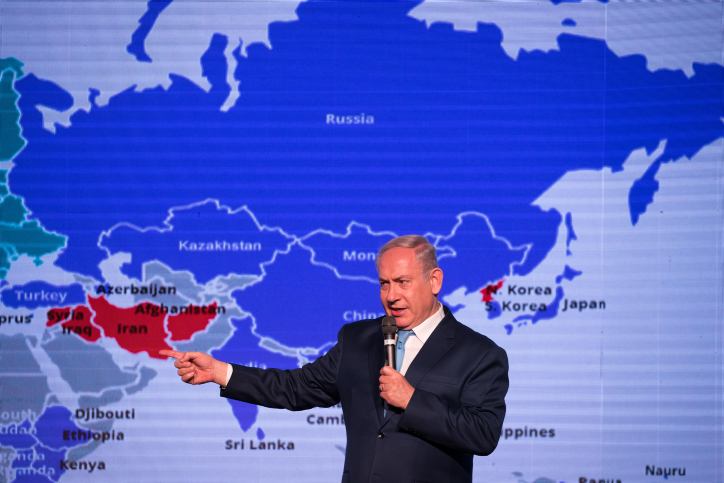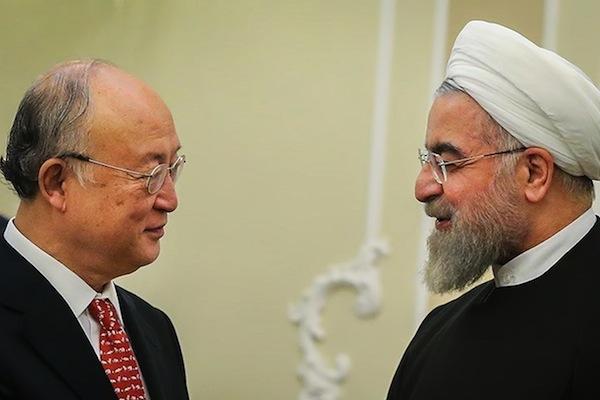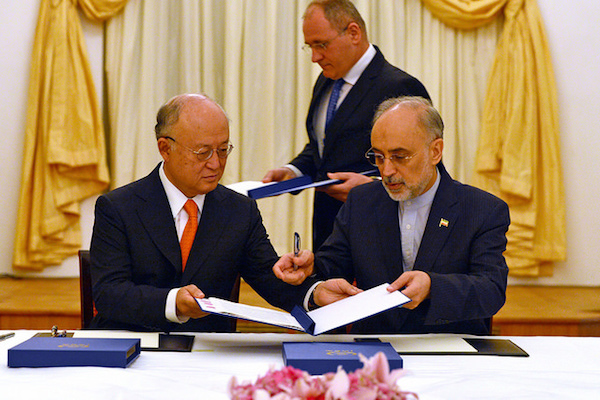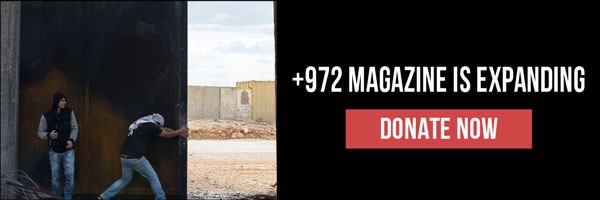Netanyahu is repeating the claim that, following the nuclear deal, Iran will soon amass an arsenal of a hundred bombs. That couldn’t be farther from the truth.
By Shemuel Meir

Speaking at the Jerusalem Post’s Diplomatic Conference on December 6th, 2017, Prime Minister Netanyahu stated that, within a decade, Iran stands to emerge from the nuclear deal with not one atomic bomb but “a nuclear arsenal of 100 bombs and more.” He called upon the ambassadors present to report this to their respective foreign offices and have their countries help the U.S. President fix the “flawed” Iran nuclear deal right away.
Netanyahu had elaborated on his “one hundred atomic bombs” thesis during his London talk at the Chatham House a month earlier. According to him, Iran would do well to honor the deal rather than risk its violation. If the Islamic Republic walked out on the agreement now, it might end up having one bomb, but if it were to silently bide its time until the agreement ran out and the restrictions were lifted, it would rack up a hundred atomic bombs “within weeks.”
Netanyahu’s is a misguided thesis, not founded in fact, and most likely the result of questionable strategic counseling. Whether it is shared by Israel’s military intelligence — responsible for the National Intelligence Estimate — is unclear. Israeli think tanks, whose job is to challenge establishment thinking and present the prime minister with reports based on facts, seem inclined to fuel and exacerbate Netanyahu’s pessimistic approach and worldview. Thus, the public debate in Israel is exposed to a vicious circle of threats and fear-mongering. The argument voiced in Israel that Iran has not changed and remains a serial violator of the Non-Proliferation Treaty (NPT) does nothing to help the debate.
In this article, we will show where Netanyahu is wrong. The nuclear deal is not a fast track to an Iranian bomb.
The Netanyahu school considers the agreement “flawed” based on its notion that Iran has managed to foist the so-called Sunset Clause on the U.S. and other global powers. The Sunset Clause is a legal metaphor implying that the restrictions on uranium stockpiles set forth in the deal (300 kilograms only as opposed to 10 tons prior to the agreement) and additional prohibitions on uranium enrichment in Iran will expire in 15 years. When this period ends, according to Netanyahu’s school of thought, Iran will spring forth and develop nuclear weapons in no time. Hence, the “hundred atomic bombs” thesis. Proponents of the school have recently been saying that this will happen within 7-8 years.
It is unclear how this giant leap is supposed to happen in practice, and there is no factual basis to support it. The Sunset Clause, which has become a red flag for opponents of the agreement, is no Iranian ploy, but a standard clause in international agreements, and more so nuclear disarmament agreements. Furthermore, low civilian-grade enriched uranium (up to five percent) cannot be used to produce fissionable material for a bomb. To achieve this, uranium must be enriched to 93 percent weapons-grade level.
When the deal comes to an end and the Sunset Clause expires, Iran will still be banned from enriching uranium to weapons-grade levels and will not be able to produce fissionable material for a bomb. This is the essence of Iran’s commitment to the “Non-Nuclear-Weapon State (NNWS)” status under the NPT: to neither develop nor in any way acquire nuclear weapons.
This, after all, is the whole point. The Netanyahu school has made the Sunset Clause a flagship cause in its efforts to shoot down the agreement (or “fix” it, to use Netanyahu’s and Trump’s euphemism). The Sunset Clause also took center stage in Netanyahu’s annual Iranian-threat speech last September at the UN General Assembly. But the ban on weapons-grade uranium enrichment under the NPT and the intrusive inspection regime enforced by the International Atomic Energy Agency (IAEA) — with the ability to ensure that no military uranium enrichment is taking place — are permanent and not limited by time. Even if Iran develops fast new centrifuges and is permitted to build them when the Sunset Clause expires, it will be banned from weapons-grade uranium enrichment.
The Israeli reader is unaware of the intrusive inspection regime imposed upon Iran’s civilian nuclear program, which prevents it from diverting materials to a secret military program. It is only thanks to the far-reaching inspection regime that Director General of the IAEA, Yukiya Amano, can issue a quarterly declaration that Iran is in compliance with the deal. IAEA inspectors practically live on site at the only uranium enrichment plant in Natanz, visiting it on a daily basis, including the storage facilities housing the 14,000 centrifuges removed from the Iranian project, which are currently being used strictly as a reserve for spare parts.

In 2016, IAEA inspectors conducted 402 such inspection visits, a figure that would have been inconceivable in the pre-deal years. The IAEA also uses advanced technological means, satellite images, and surveillance cameras transmitting live, nonstop feeds to the agency’s Vienna headquarters. The IAEA is helped by the intelligence services of the agency’s member states, and in particular the signatory powers to the Iran nuclear deal. A statement by the Chairman of the U.S. Joint Chiefs of Staff in a Senate hearing on Iran’s upholding of the nuclear deal was based, according to him, on intelligence materials. Had a breach of the deal been suspected, American intelligence would have sounded an alarm and alerted the IAEA. This has not happened.
Moreover, the intrusive inspection regime aimed at preventing diversion of materials toward military enrichment in secret sites will remain in place even after “sunset.” The IAEA’s inspection and the NPT are not time-bound and will also allow the IAEA to inspect undeclared suspicious sites, including military ones. It will be able to do so by virtue of the Additional Protocol signed by Iran when the nuclear deal took effect. The Additional Protocol has no expiry date.
The Additional Protocol is a pillar of the IAEA’s inspection efforts aimed at preventing the creation of a secret parallel program outside the declared sites. Contrary to information provided by “a Western intelligence organization” leaked in the Israeli media, Iran did not deny the IAEA access to undeclared sites. The Director General of the IAEA has denied these leaks, and his spokesman, in an unusual act, sent an email refuting the story to a news channel in Israel. In 2016, the IAEA conducted 25 inspection visits on short notice to undeclared suspicious sites. That translates into two visits per month. Some of the undeclared sites may have been located in army bases. In any event, none of the agency’s demands were obstructed by the Iranians.

According to our analysis, Netanyahu’s alarmist “hundred atomic bombs” scenario is not going to materialize. The IAEA’s intrusive inspection regime imposed on Iran’s civilian nuclear program is designed to keep close tabs, deter, and prevent deception. Iran will not be able to make and build an arsenal of atomic bombs “under the IAEA spotlight” using a tightly-controlled civilian nuclear program as a springboard. Countries that have acquired nuclear weapons, like India and Pakistan, have done so far from the watchful eyes of the IAEA and the NPT since they are not signatories to NPT.
The Iran nucelar deal and the most intrusive inspection regime in nuclear history have cut off the two possible tracks leading to nuclear weapons — weapons-grade uranium enrichment and plutonium. This is not some temporary freeze.
Paradoxically, Israel, which is not a signatory of the NPT, is among the countries that stand to benefit most from the agreement that Netanyahu and Trump are trying to thwart — an agreement that has blocked the emergence of a new nuclear state in the Middle East and prevented a nuclear armaments race, with other countries in the region scrambling to go nuclear. This is the nuclear deal’s positive contribution to Israel’s national security.
Shemuel Meir is a former IDF analyst and associate researcher at the Jaffee Center for Strategic Studies at Tel Aviv University. Today he is an independent researcher on nuclear and strategic issues and author of the “Strategic Discourse” blog, which appears in Haaretz. Read this post in Hebrew here.


